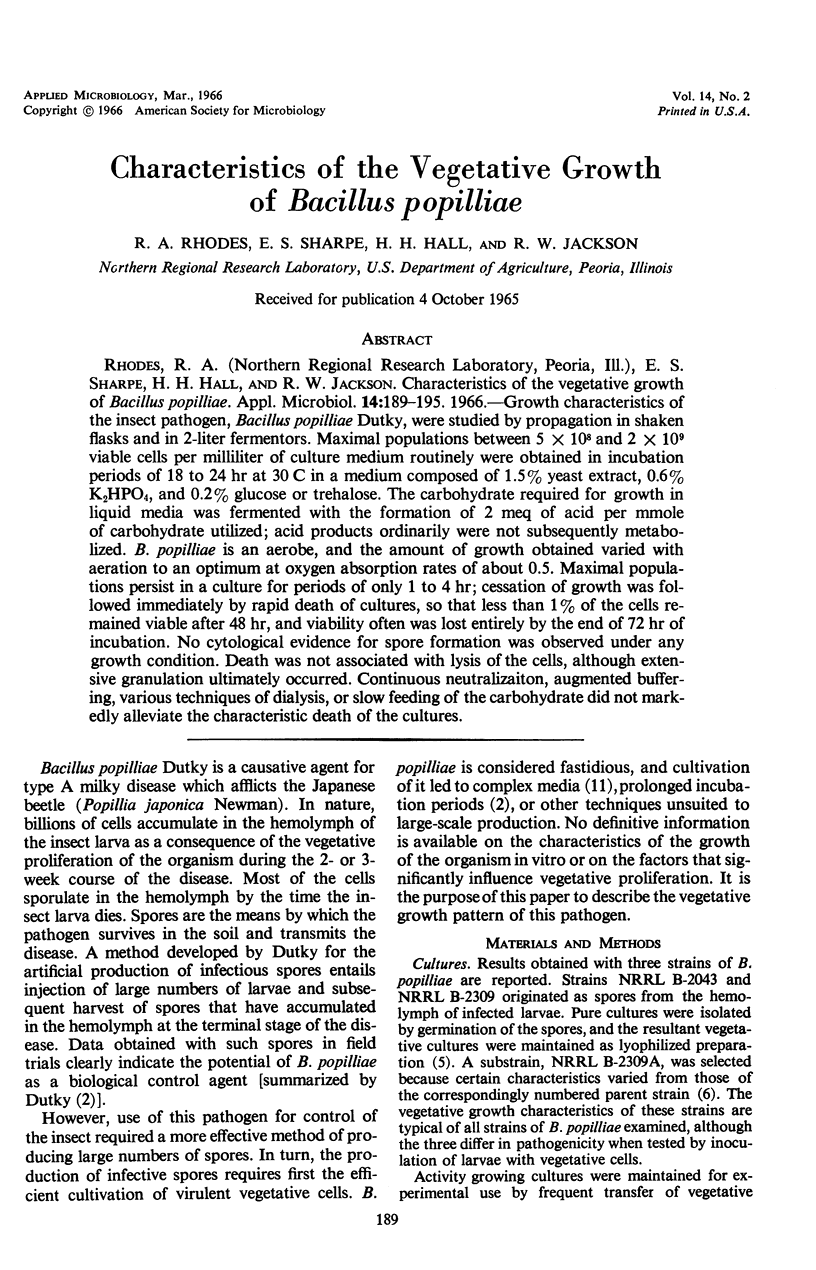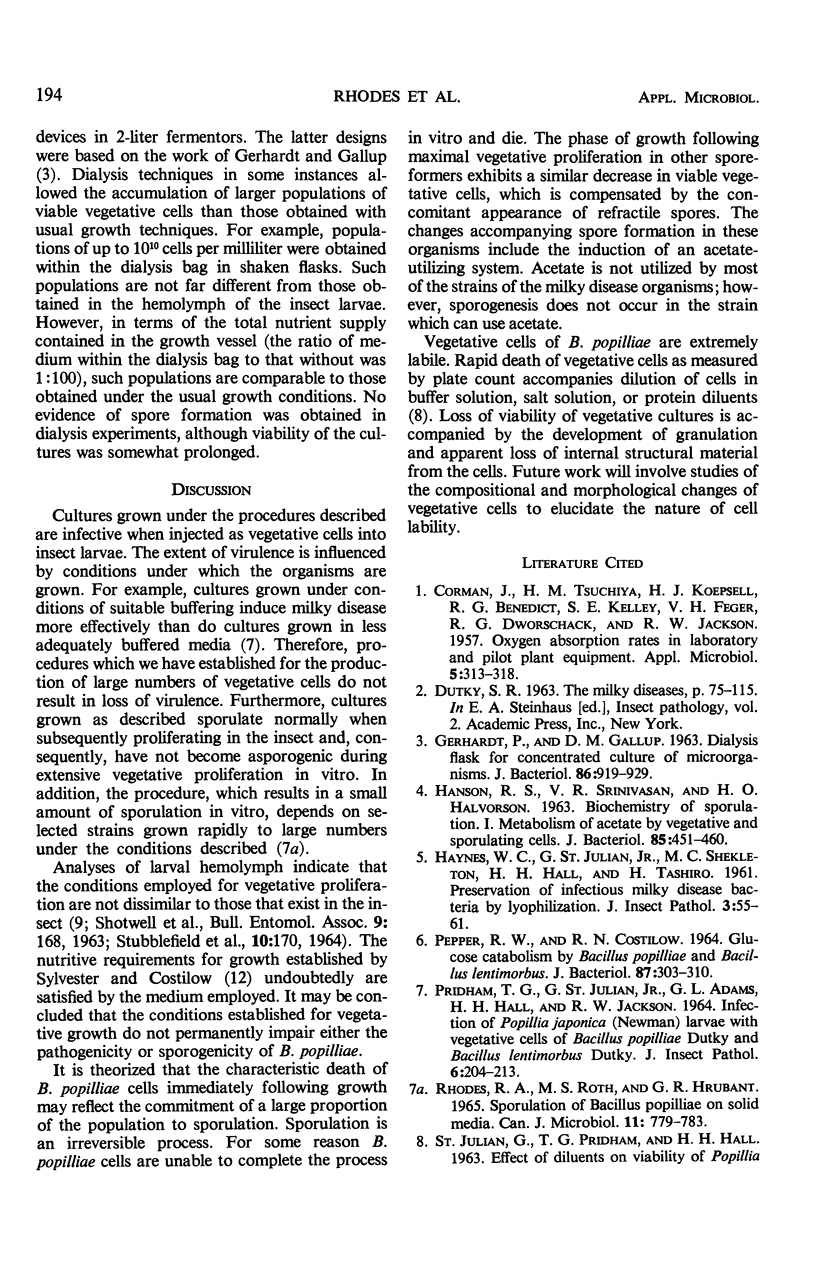Abstract
Growth characteristics of the insect pathogen, Bacillus popilliae Dutky, were studied by propagation in shaken flasks and in 2-liter fermentors. Maximal populations between 5 × 108 and 2 × 109 viable cells per milliliter of culture medium routinely were obtained in incubation periods of 18 to 24 hr at 30 C in a medium composed of 1.5% yeast extract, 0.6% K2HPO4, and 0.2% glucose or trehalose. The carbohydrate required for growth in liquid media was fermented with the formation of 2 meq of acid per mmole of carbohydrate utilized; acid products ordinarily were not subsequently metabolized. B. popilliae is an aerobe, and the amount of growth obtained varied with aeration to an optimum at oxygen absorption rates of about 0.5. Maximal populations persist in a culture for periods of only 1 to 4 hr; cessation of growth was followed immediately by rapid death of cultures, so that less than 1% of the cells remained viable after 48 hr, and viability often was lost entirely by the end of 72 hr of incubation. No cytological evidence for spore formation was observed under any growth condition. Death was not associated with lysis of the cells, although extensive granulation ultimately occurred. Continuous neutralizaiton, augmented buffering, various techniques of dialysis, or slow feeding of the carbohydrate did not markedly alleviate the characteristic death of the cultures.
Full text
PDF






Images in this article
Selected References
These references are in PubMed. This may not be the complete list of references from this article.
- CORMAN J., TSUCHIYA H. M., KOEPSELL H. J., BENEDICT R. G., KELLEY S. E., FEGER V. H., DWORSCHACK R. G., JACKSON R. W. Oxygen absorption rates in laboratory and pilot plant equipment. Appl Microbiol. 1957 Sep;5(5):313–318. doi: 10.1128/am.5.5.313-318.1957. [DOI] [PMC free article] [PubMed] [Google Scholar]
- GERHARDT P., GALLUP D. M. DIALYSIS FLASK FOR CONCENTRATED CULTURE OF MICROORGANISMS. J Bacteriol. 1963 Nov;86:919–929. doi: 10.1128/jb.86.5.919-929.1963. [DOI] [PMC free article] [PubMed] [Google Scholar]
- HANSON R. S., SRINIVASAN V. R., HALVORSON H. O. Biochemistry of sporulation. I. Metabolism of acetate by vegetative and sporulating cells. J Bacteriol. 1963 Feb;85:451–460. doi: 10.1128/jb.85.2.451-460.1963. [DOI] [PMC free article] [PubMed] [Google Scholar]
- PEPPER R. E., COSTILOW R. N. GLUCOSE CATABOLISM BY BACILLUS POPILLIAE AND BACILLUS LENTIMORBUS. J Bacteriol. 1964 Feb;87:303–310. doi: 10.1128/jb.87.2.303-310.1964. [DOI] [PMC free article] [PubMed] [Google Scholar]
- Rhodes R. A., Roth M. S., Hrubant G. R. Sporulation of bacillus popilliae on solid media. Can J Microbiol. 1965 Oct;11(5):779–783. doi: 10.1139/m65-105. [DOI] [PubMed] [Google Scholar]
- STEINKRAUS K. H. Studies on the milky disease organisms. I. Parasitic growth and sporulation of Bacillus popilliae. J Bacteriol. 1957 Nov;74(5):621–624. doi: 10.1128/jb.74.5.621-624.1957. [DOI] [PMC free article] [PubMed] [Google Scholar]
- STEINKRAUS K. H. Studies on the milky disease organisms. II. Saprophytic growth of Bacillus popilliae. J Bacteriol. 1957 Nov;74(5):625–632. doi: 10.1128/jb.74.5.625-632.1957. [DOI] [PMC free article] [PubMed] [Google Scholar]
- SYLVESTER C. J., COSTILOW R. N. NUTRITIONAL REQUIREMENTS OF BACILLUS POPILLIAE. J Bacteriol. 1964 Jan;87:114–119. doi: 10.1128/jb.87.1.114-119.1964. [DOI] [PMC free article] [PubMed] [Google Scholar]




